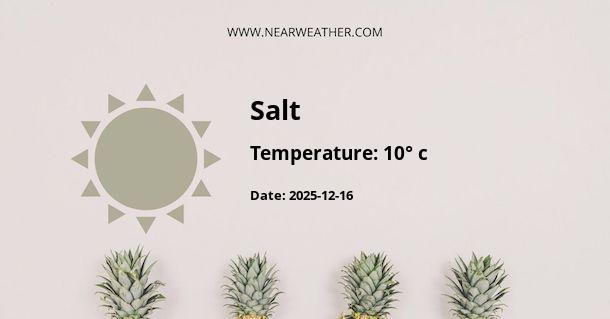Introduction
Salt, officially known as Al-Salt, is an ancient town located in the Balqa Governorate of Jordan. Known for its rich history and architectural heritage, the area boasts a unique climate that significantly impacts the lifestyles and activities of its inhabitants. This article provides an in-depth look at the climate and weather of Salt, Jordan throughout the year.
Overview of Salt's Climate
Salt, Jordan, lies within a Mediterranean climate zone with a semi-arid influence. The city experiences hot, dry summers and mild, wet winters. This climate is characterized by its two primary seasons: a hot, dry season from April to October and a cool, wet season from November to March.
| Climate Factor | Description |
|---|---|
| Annual Average Temperature | 18.2°C (64.8°F) |
| Annual Average Rainfall | Approximately 500 mm |
| Summer Temperature | Average highs of 30°C (86°F) |
| Winter Temperature | Average lows of 7°C (44.6°F) |
Monthly Weather Breakdown
Understanding the monthly variations in Salt’s weather can provide a clearer picture of what to expect throughout the year.
- January: January is the coldest month, with temperatures ranging from 5°C (41°F) to 12°C (53.6°F). It also receives the highest rainfall, averaging around 83 mm.
- February: February sees slightly warmer temperatures, ranging from 6°C (42.8°F) to 14°C (57.2°F), with an average rainfall of 75 mm.
- March: The temperatures in March range between 8°C (46.4°F) and 18°C (64.4°F), with a significant decrease in rainfall to around 50 mm.
- April: April marks the onset of the dry season, with temperatures ranging from 11°C (51.8°F) to 23°C (73.4°F). The rainfall drops to an average of 25 mm.
- May through September: These months constitute the peak of the dry season, with virtually no rainfall. Temperatures can reach up to 32°C (89.6°F) during the day and drop to around 16°C (60.8°F) during the night.
- October: October signals the end of the dry season, with temperatures ranging from 14°C (57.2°F) to 27°C (80.6°F) and an average rainfall of 15 mm.
- November and December: The wet season begins in November, with temperatures dropping to a range of 8°C (46.4°F) to 18°C (64.4°F) in November and 5°C (41°F) to 12°C (53.6°F) in December. Rainfall increases to an average of 60 mm in November and 75 mm in December.
Conclusion
In conclusion, Salt’s Mediterranean climate with a semi-arid influence offers a unique blend of hot, dry summers and mild, wet winters. This climate plays a significant role in the lifestyle and activities of its residents and visitors. While the summer months offer opportunities for outdoor activities and sightseeing, the winter months provide a chance to experience the city’s unique cultural heritage amidst mild, rainy weather.
"A visit to Salt, Jordan, offers a chance to experience the city's unique cultural heritage amidst a climate characterized by hot, dry summers and mild, wet winters." - Anonymous
Whether you're planning a visit or merely interested in learning more about this historic city's climate, understanding Salt's weather patterns can provide valuable insight into the unique charm and atmosphere that this city has to offer.
A - Salt's Latitude is 32.039169 & Longitude is 35.727219.
A - Weather in Salt is 17° today.
A - Climate Conditions in Salt shows clear sky today.
A - Humidity in Salt is 33% today.
A - Wind speed in Salt is 15.84 km/h, flowing at 114° wind direction. today.
